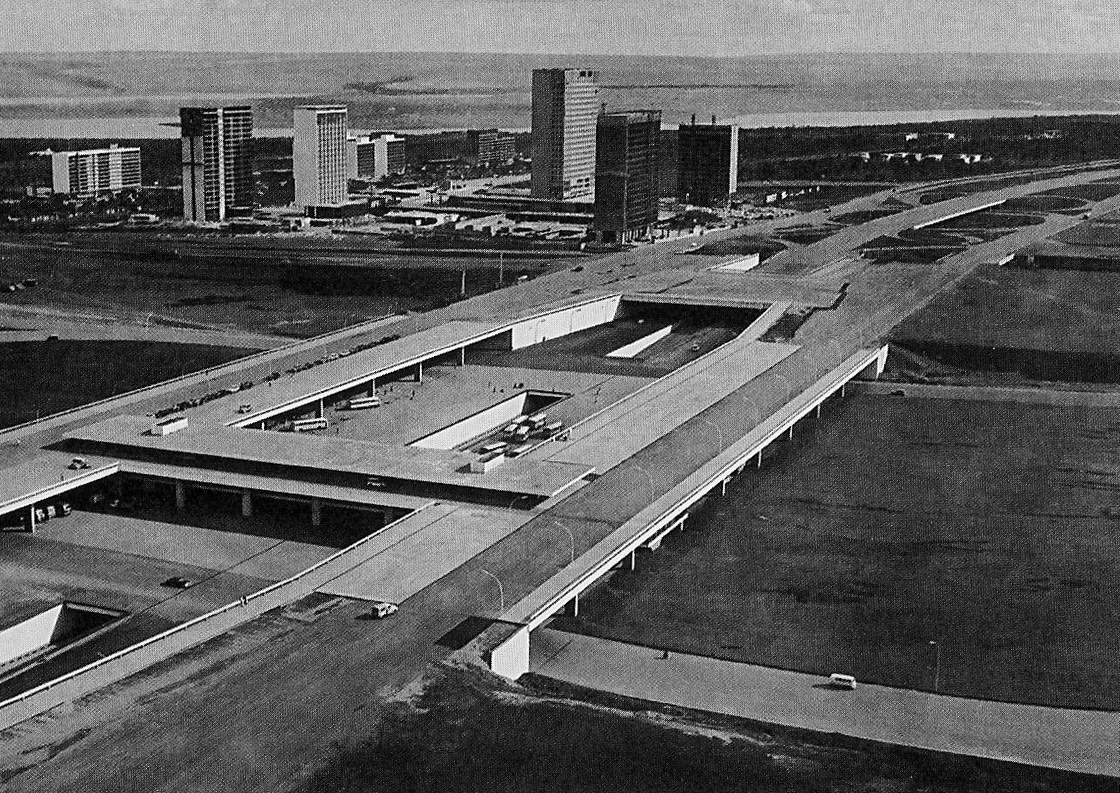Professor
Carlos Alberto Maciel [BR]

Brasilia central platform, Lucio Costa, 1957
A conceptual proposition
Could existing infrastructures become architecture?
Could architecture be conceived as infrastructure?
Both questions relate to the theme of the disappearance. First, in a physical way, the appropriation of existing obsolete industrial infrastructures results in an architecture that has a given formal and built configuration, that should be transformed and activated for an everyday use. Architecture disappears as a personal design input in a landscape. It is partially given. Second, in a metaphorical way, conceiving architecture as infrastructures presupposes that the building could be thought as a platform interconnected to the urban structure and to other buildings in a systemic view, and its symbolical and functional characteristics are not pre-determined, but emerge over time through use.
Both approaches look beyond immediate functions. The main concern is to create open indeterminate spaces that could accommodate the most varied field of uses and activities. The main actions consist in developing virtuous spatial and built arrangements and in creating the most varied articulations between architecture and the urban realm, considering the borders as a main field of research and action.
Would it be possible to reactivate and transform Porto Marghera in an urban vivid city through these two approaches?
A collaborative process
All ideas belong to everybody. Once presented publicly, they can be appropriated and transformed in other hands. To reach this, we will have one single rule: after a collective presentation, each workgroup should choose another proposition among all the presented to be continued in the next phase, except its own. The most powerful and fertile propositions probably will be chosen by more groups, and the successive change of the ideas among groups tends to blur authorial issues and create a collaborative effort in multiple propositions.
This process is designed in three phases, that correspond to the three weeks of the workshop:
1 – conceptual propositions
2 – technical development of the ideas
3 – final design and presentation
The first two phases have, each, two public presentations. After each presentation, each team is supposed to choose another proposition to continue.
Un approccio concettuale
Può l’infrastruttura esistente diventare architettura?
Può l’architettura essere concepita come un’infrastruttura?
Entrambe le questioni sono relazionate al tema dell’assenza. In primo luogo, da un punto di vista fisico, la riappropriazione di infrastrutture industriali obsolete dà origine ad un’architettura che ha una configurazione formale e costruttiva predeterminata, le quali saranno trasformate e riattivate per un utilizzo quotidiano. In questo modo l’architettura, intesa come segno autoreferenziale nel paesaggio, scompare essendo parzialmente già data. In secondo luogo, da un punto di vista metaforico, concepire l’architettura come un’infrastruttura presuppone il fatto che l’edifico possa essere pensato come una piattaforma interconnessa alla struttura urbana e agli edifici in una visione sistemica, le cui caratteristiche simboliche e funzionali non siano predeterminate, ma emergano nel corso tempo e attraverso l’utilizzo.
Entrambi gli approcci guardano al di là delle funzioni immediate. L’interesse principale è quello di creare spazi indeterminati che possano ospitare la maggiore varietà possibile di usi e attività. Le operazioni principali consistono nello sviluppare virtuose composizioni spaziali e costruttive capaci di creare la maggiore varietà possibile di articolazioni tra l’architettura e l’ambito urbano considerando i margini come principale campo di ricerca e di azione.
Sarà possibile riattivare e trasformare Porto Marghera in una vivida realtà urbana attraverso questi due approcci?
Un processo collaborativo
Tutte le idee appartengo a tutti. Una volta presentate pubblicamente alla classe, esse possono essere assorbite e trasformate da altre mani. Per raggiungere ciò utilizzeremo una sola regola: dopo la presentazione collettiva, ciascun gruppo di lavoro dovrà scegliere una proposta tra tutte quelle presentate che sarà sviluppata nella fase successiva, purché non sia la propria. Le proposte più potenti e fertili probabilmente saranno scelte da più gruppi, e il successivo scambio di idee tra i gruppi porterà a confondere le questioni relative all’autore e a creare uno sforzo collaborativo in molteplici proposte.
Questo processo è sviluppato in tre fasi che corrispondono alle tre settimane di workshop:
1- proposte concettuali
2- sviluppo tecnico delle idee
3- disegni finali e presentazione
Le prime due fasi hanno, ciascuna, due presentazioni pubbliche. Dopo ogni presentazione, ciascun gruppo dovrà scegliere un’altra proposta da portare avanti.
